Health Cluster pivots cross-cluster collaboration for delivery of integrated service package among underserved communities
17 July 2022 – In 2021, Somalia barely had time to take its eye off the COVID-19 pandemic, when the ongoing severe drought crept up. As a result, many Somali communities, over 40% of whom are known to live rural and nomadic lifestyles, lost their livestock and crops.
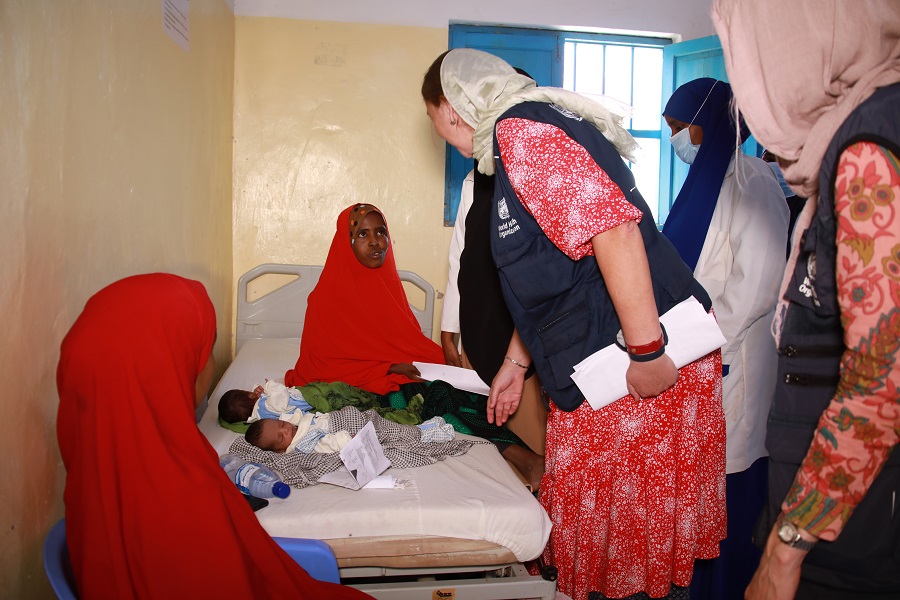 Health Cluster Coordinator for Somalia Ms Erna-Roelofje Christina Van Goor visits a hospital in Dhushamareb to view health services being offered, Galgaduud, June 2022. Credit: WHO Somalia/Fouzia BanoTo deliver a multifaceted response to the ongoing drought, Somalia’s Health Cluster has been working hand in hand with international and national health agencies in the country.
Health Cluster Coordinator for Somalia Ms Erna-Roelofje Christina Van Goor visits a hospital in Dhushamareb to view health services being offered, Galgaduud, June 2022. Credit: WHO Somalia/Fouzia BanoTo deliver a multifaceted response to the ongoing drought, Somalia’s Health Cluster has been working hand in hand with international and national health agencies in the country.
Delivering a joint response with partners
Led by the World Health Organization (WHO), the Health Cluster convened regular meetings with partners, including the federal and state ministries of health, where the Organization shared updates on the drought situation and the anticipated public health impacts. These meetings offered partners a platform to discuss their response activities related to the drought, in addition to gaps and challenges.
The Health Cluster has also been participating in inter-cluster platforms. Led by the United Nations Office for Humanitarian Affairs (OCHA), stakeholders’ inter-cluster response for drought entailed the reconstitution of the Drought Operations Coordination Centre. The Health Cluster is playing a key role in coordinating the overall health response in the country and working hand in hand with the water, sanitation and hygiene (WASH) and nutrition clusters for programmatic integrations.
Health Cluster partners have so far benefited from 2 rounds of Somalia Humanitarian Fund allocations, that amounted to approximately US $9 million to respond to the drought, targeting the most severely affected populations. These allocations have taken advantage of the cross-cluster collaboration, with most funding channeled to integrated health, nutrition and WASH projects.
Visiting the most hard-hit drought-affected areas
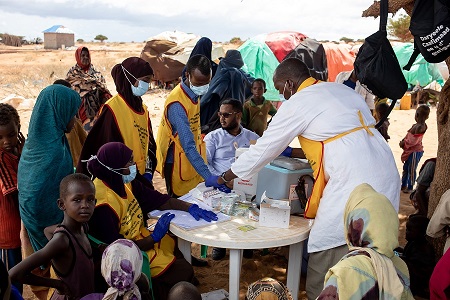 The Health Cluster serves as a coordinating body for health actors across Somalia to ensure the most vulnerable people have access to health services, Istanbul internally displaced persons camp, Jubaland, May 2022. Credit: WHO Somalia/AreteThe Health Cluster participated in inter-cluster caravan missions to various drought-affected areas to assess the health situation, identify gaps and opportunities for support. The areas visited include Bardhere, Luuq and Elwak in Gedo region, Garowe, Hargeisa and Jowhar, among other areas severely affected by the drought. From these missions, the Cluster observed the high prevalence of waterborne disease outbreaks, mainly due to a lack of sufficient clean water and hygiene services.
The Health Cluster serves as a coordinating body for health actors across Somalia to ensure the most vulnerable people have access to health services, Istanbul internally displaced persons camp, Jubaland, May 2022. Credit: WHO Somalia/AreteThe Health Cluster participated in inter-cluster caravan missions to various drought-affected areas to assess the health situation, identify gaps and opportunities for support. The areas visited include Bardhere, Luuq and Elwak in Gedo region, Garowe, Hargeisa and Jowhar, among other areas severely affected by the drought. From these missions, the Cluster observed the high prevalence of waterborne disease outbreaks, mainly due to a lack of sufficient clean water and hygiene services.
Suspected measles cases were also observed in most areas, including in camps for internally displaced persons (IDPs), where families complained about rashes and high-grade symptoms. The team noted large numbers of people suffering from malnutrition, which is known to be a key contributing factor in susceptibility to diseases, especially among children under 5.
Mental health and gender-based violence risks during drought
Mental health and psychosocial support services remain a key gap in internally displaced persons camps, with children showing signs of trauma and depression, as noted by the Cluster. The emotional impact of changes to family and community life appears to have affected children’s lives in the camps at alarming rates. Interaction with women in the camps revealed high cases of gender-based violence, mostly attributed to the lack of shelter as most newly arrived women and girls sleep outdoors.
As a result of these missions and observations made, funding allocation has been better prioritized to reach the most vulnerable populations in these severely affected areas. An integrated approach to the response to drought has been noted as the most effective and efficient way of providing assistance. These caravan missions have also provided an opportunity to monitor partners’ interventions related to health. However, as the agencies struggle to step up effective drought response, the needs of the underserved communities are clearly outpacing the available services.
Turning hope into happiness: rehabilitating boreholes in a hard-to-reach area in Somalia shows promises of a happy life
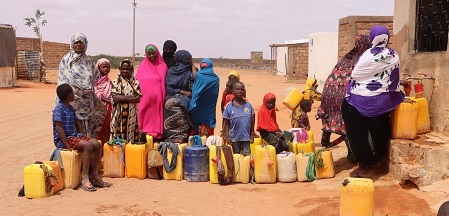 Children and adults queuing to collect water from the newly rehabilitated Salama borehole, North Galkayo, Puntland, 2 July 2022. Credit: WHO Somalia6 July 2022 – Water is a key prerequisite to safe hygiene and sanitation practices and — by that measure — good health and dignity. However, a large proportion of the Somali population has limited access to this valuable resource. Estimates from a survey conducted by the government and UN in 2014 state that 24% of Somalis live in rural areas, 23% follow nomadic lifestyles, and 15% (around 2.6 million) live in camps for the internally displaced. This means most communities living across Somalia’s expansive, dry landscape rely on rivers, wells, water trucks and boreholes to access water of compromised quality. The ongoing drought, which is the worst the Horn of Africa has witnessed in four decades, has placed water even further out of reach.
Children and adults queuing to collect water from the newly rehabilitated Salama borehole, North Galkayo, Puntland, 2 July 2022. Credit: WHO Somalia6 July 2022 – Water is a key prerequisite to safe hygiene and sanitation practices and — by that measure — good health and dignity. However, a large proportion of the Somali population has limited access to this valuable resource. Estimates from a survey conducted by the government and UN in 2014 state that 24% of Somalis live in rural areas, 23% follow nomadic lifestyles, and 15% (around 2.6 million) live in camps for the internally displaced. This means most communities living across Somalia’s expansive, dry landscape rely on rivers, wells, water trucks and boreholes to access water of compromised quality. The ongoing drought, which is the worst the Horn of Africa has witnessed in four decades, has placed water even further out of reach.
Visit to camps for internally displaced persons
On a bright, sunny morning on 10 May 2022, a high-level mission from Somalia’s Federal Ministry of Health and Human Services, the Puntland state Ministry of Health and the World Health Organization (WHO) visited North Galkayo to assess the health situation brought about by the drought.
Led by HE Dr Fawziya Abikar Nur, the Federal Minister of Health and Human Services, and HE Abdi Nasir Yusuf Haji, the Vice Minister of Health for Puntland state, the team included Dr Ahmed Al-Mandhari, the Regional Director for the WHO Eastern Mediterranean Regional Office and Dr Mamunur Rahman Malik, WHO Representative to Somalia.
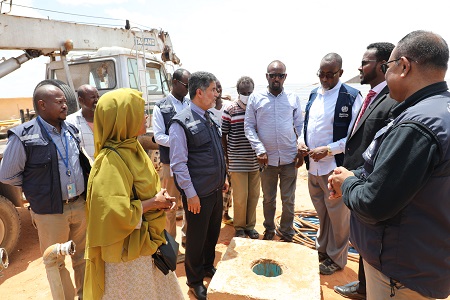 Dr Ahmed Al-Mandhari, WHO Regional Director for the Eastern Mediterranean, and Dr Mamunur Malik, WHO Representative to Somalia, visiting the Salama borehole when it was not functioning, North Galkayo, 10 May 2022. Credit: WHO Somalia/Fouzia Bano
Dr Ahmed Al-Mandhari, WHO Regional Director for the Eastern Mediterranean, and Dr Mamunur Malik, WHO Representative to Somalia, visiting the Salama borehole when it was not functioning, North Galkayo, 10 May 2022. Credit: WHO Somalia/Fouzia Bano
During a visit to two camps for internally displaced persons (IDPs)– the Salama and Halaboqad camps – the team observed that the communities living there had no access to water. At the Salama camp, a borehole that used to provide water to around 2000 households and 12 000 people residing in six camps was broken. Similarly, the borehole at the Halaboqad camp, which usually serves around 7716 people, was not functioning as its water pump required solar batteries or a generator and pipes to carry water.
When delivering promises turns into happiness
The local communities, while meeting Dr Al-Mandhari and Dr Malik, raised their attention of the acute water shortage they were facing in the camp. After seeing the plight of the local communities and believing that access to safe water is a human right for everyone, everywhere, Dr Ahmed Al-Mandhari and Dr Malik committed to support the rehabilitation of two boreholes in both camps, which can permanently solve the acute water crisis faced by marginalized community members. Within the same week, WHO arranged for engineers to assess both boreholes.
In a month’s time, by 16 June 2022, both boreholes were rehabilitated, and a total of around 19 716 people living in both locations now have access to safe water, which has already started to change the life of these communities. This intervention will significantly reduce the prevalence of diseases among communities being served in addition to meeting their daily needs for water. The communities are happily using safe water from this borehole for all their household needs and thanking WHO for delivering its promises to safeguard lives of their children and elderly people.
WHO urges partners to redouble efforts
During his mission, Dr Ahmed Al-Mandhari urged partners to redouble efforts to support Somali communities during this trying time.
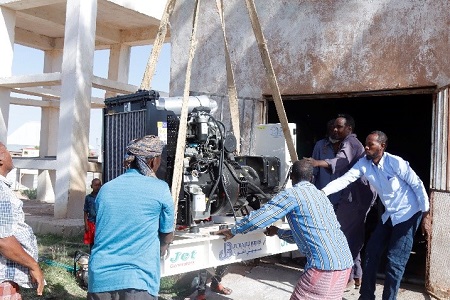 Rehabilitation efforts at the Halaboqad borehole after the high-level visit, North Galkayo, June 2022. Credit: WHO Somalia “It is really very heart-breaking to see the impact of drought. Let us come together to save lives,” said Dr Ahmed Al-Mandhari, the WHO Regional Director for Eastern Mediterranean Regional Office. “We see children, mothers and families suffering due to the shortage of water and food. I have seen young babies emaciated and admitted in hospitals due to malnutrition and related complications, such as pneumonia. These are all not just numbers, but human lives, and future generations of Somalia suffering from drought and the related impact of it – physical, mental, emotional or psychological. Let us all work towards fulfilling the spirit and values of the WHO Eastern Mediterranean Region vision 2023: health for all by all – calling for solidarity and action.”
Rehabilitation efforts at the Halaboqad borehole after the high-level visit, North Galkayo, June 2022. Credit: WHO Somalia “It is really very heart-breaking to see the impact of drought. Let us come together to save lives,” said Dr Ahmed Al-Mandhari, the WHO Regional Director for Eastern Mediterranean Regional Office. “We see children, mothers and families suffering due to the shortage of water and food. I have seen young babies emaciated and admitted in hospitals due to malnutrition and related complications, such as pneumonia. These are all not just numbers, but human lives, and future generations of Somalia suffering from drought and the related impact of it – physical, mental, emotional or psychological. Let us all work towards fulfilling the spirit and values of the WHO Eastern Mediterranean Region vision 2023: health for all by all – calling for solidarity and action.”
“Currently, 3.5 million people in Somalia lack adequate access to water,” said Dr Mamunur Malik. “This increases communities’ chances of contracting diseases like cholera and diarrhoea. We are hereby appealing to both the health and the water, sanitation and hygiene (WASH) clusters in Somalia to work hand in hand to protect Somalis from preventable diseases and give them access to safe water and sanitation services, which are their human right.”
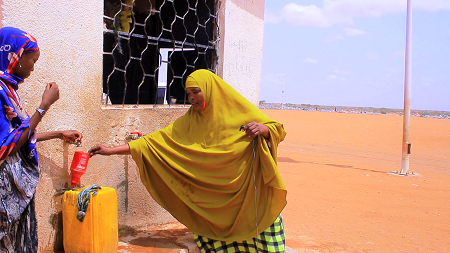 A lady draws water for her household from the Salama borehole, North Galkayo, July 2022, Credit: WHO SomaliaDr Malik added that WHO estimates that for every US $1 that donors and partners spend today to prevent and prepare for epidemics in Somalia, it will save US$ 35 in response to epidemics. Early action saves more lives, he emphasized.
A lady draws water for her household from the Salama borehole, North Galkayo, July 2022, Credit: WHO SomaliaDr Malik added that WHO estimates that for every US $1 that donors and partners spend today to prevent and prepare for epidemics in Somalia, it will save US$ 35 in response to epidemics. Early action saves more lives, he emphasized.
Protecting children from measles in drought-affected Somalia
27 June 2022 – When young Nastexo and Salmo developed high fevers, coughs, sore throats, runny noses and watery eyes, Ilmo may not have known exactly what problem her children had, but their rashes gave it away. Ilmo, who lives in a drought-affected location in Baidoa, knew her children had measles as she had seen many cases recently and had learnt to look out for these symptoms.
Ilmo felt helpless and tired when they both fell sick with this highly contagious disease, as they needed her undivided attention. Upon receiving advice from community health workers, she took Nastexo and Salmo to a health facility nearby where a doctor gave them vitamin A to boost their immunity and medication to give them relief.
 Health workers use vaccine carriers to store measles vaccines at the optimum temperature while visiting children to vaccinate them during house-to-house visits in the Istanbul IDP camp in Kismayo, Jubbaland state (April 2022). Credit: WHO Somalia/AreteIn collaboration with the Federal Ministry of Health and Human Services and partners, the World Health Organization (WHO) is supporting the work of 2163 community health workers who visit around 300 000 households every month across Somalia to look out for sick children in the households whose parents do not visit the health centres to seek health care for their sick children owing to myriad of reasons. These community health workers, deployed by WHO in the worst affected areas, look for sick children with suspected measles, pneumonia, diarrhoea or suspected cholera and malaria. They also screen children for signs of acute malnutrition using mid-upper arm circumference measuring tapes and search for other unusual health events in the community. This regular search helps communities to seek health care in a timely manner, which saves lives.
Health workers use vaccine carriers to store measles vaccines at the optimum temperature while visiting children to vaccinate them during house-to-house visits in the Istanbul IDP camp in Kismayo, Jubbaland state (April 2022). Credit: WHO Somalia/AreteIn collaboration with the Federal Ministry of Health and Human Services and partners, the World Health Organization (WHO) is supporting the work of 2163 community health workers who visit around 300 000 households every month across Somalia to look out for sick children in the households whose parents do not visit the health centres to seek health care for their sick children owing to myriad of reasons. These community health workers, deployed by WHO in the worst affected areas, look for sick children with suspected measles, pneumonia, diarrhoea or suspected cholera and malaria. They also screen children for signs of acute malnutrition using mid-upper arm circumference measuring tapes and search for other unusual health events in the community. This regular search helps communities to seek health care in a timely manner, which saves lives.
Hunger setting the stage for measles spread
The ongoing drought in the Horn of Africa, which WHO recently classified as a grade three health emergency – meaning that it is a severe crisis – is leaving children weak, hungry and susceptible to disease. Out of 6.1 million people across the country who are food insecure, nearly 1.7 million are suffering from extreme levels of hunger. An estimated 1.4 million children aged under 5 and more than 250 000 pregnant and lactating women will need treatment and care for malnutrition.
From the beginning of the year until week 21 of 2022 (29 May 2022), health facilities and community health workers reported 9562 suspected cases of measles, 7650 (80%) of whom are aged under 5 years. The highest number of cases have been reported from Puntland, South West State and Banadir.
“We are going extra miles to reach out every child whose life can be saved and protected by measles and other vaccines. During the last 4 months of our intensified operation in the ground, over 92 000 children have been vaccinated against childhood vaccines including measles through our outreach services which we have supported and continue to support in the drought-affected districts. Approximately 19000 of these children were identified by our health workers as “zero dose children”, meaning that they have not received any vaccine in their life span. Unvaccinated children, coupled with malnutrition and mass displacement, will set the stage for diseases like measles to spread. Therefore, we are reaching to every child in these drought-affected districts and vaccinate them against measles and other childhood vaccines. In order to continue to maintain our life-saving interventions, we will need US$ 35 million to ramp up our operations until the end of 2022,” said Dr Mamunur Rahman Malik, WHO Representative to Somalia.
Realizing the benefits of vaccination
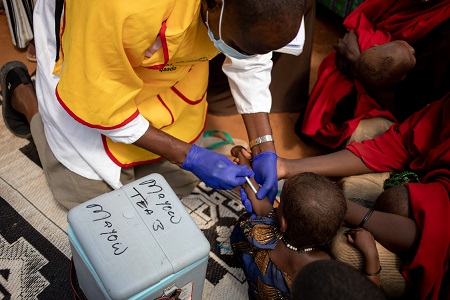 Ali Aden, a health worker, vaccinates children against measles at the Istanbul IDP camp in Kismayo, Jubbaland state (April 2022). Credit: WHO Somalia/AreteIlmo explains that she never had the chance to take Nastexo and Salmo for their childhood vaccinations, but now knows how important it is to vaccinate children. She explains that she will take the newest addition to the family, her 7-month-old baby, to receive routine childhood vaccinations to prevent him from falling sick like his siblings.
Ali Aden, a health worker, vaccinates children against measles at the Istanbul IDP camp in Kismayo, Jubbaland state (April 2022). Credit: WHO Somalia/AreteIlmo explains that she never had the chance to take Nastexo and Salmo for their childhood vaccinations, but now knows how important it is to vaccinate children. She explains that she will take the newest addition to the family, her 7-month-old baby, to receive routine childhood vaccinations to prevent him from falling sick like his siblings.
The ongoing drought in Somalia is taking a toll on the livelihoods and health of millions of Somalis. As casual labourers, Ilmo and her husband do not earn much. Since the drought began, they have found it even harder to find jobs to make a living, and now with two children unwell, they were recently forced to live on one meal a day. Ilmo’s children were lucky enough to get attention, but there are children who do not receive timely support, as well as more families that are plunged into poverty as a result of trying to address their health needs.
WHO and Ministry of Health build on innovation to create climate-resilient environmentally friendly health systems
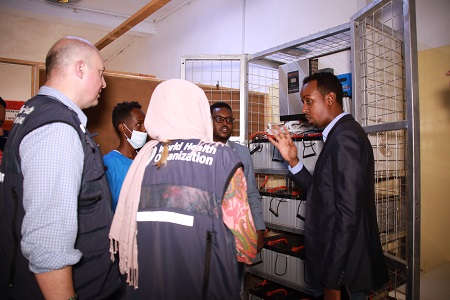 The high-level mission views the solar-powered medical oxygen plant in Dhushamareb, Somalia in June 2022. Photo credit: WHO Somalia.
The high-level mission views the solar-powered medical oxygen plant in Dhushamareb, Somalia in June 2022. Photo credit: WHO Somalia.
Mogadishu, 26 June 2022– From 13 to 17 June 2022, the Federal Ministry of Health and Human Services and the World Health Organization (WHO) country office for Somalia hosted a technical mission from WHO headquarters and Regional Office for the Eastern Mediterranean, comprising experts from the new Innovation Hub team, as well as the Environment, Climate Change, and Health team. The mission aimed to bring together key partners, including United Nations agencies, nongovernmental organizations and donors, to explore and advocate for ways to reinforce the Somali health system using climate-friendly solutions, such as the use of solar power for delivering oxygen and electrifying health facilities, especially in remote and hard-to-reach locations.
The global climate crisis, identified as the single largest health crisis facing humanity today, has resulted in an extreme phenomenon of droughts and floods occurring on an annual basis in Somalia. Meanwhile, the ongoing drought has left Somalia on the brink of famine, with a sobering 6.1 million people food insecure and 1.7 million people suffering from extreme levels of hunger.
Coupled with high rates of indoor air pollution, caused by the use of fossil fuels in households, and air temperatures which are estimated to be rising every year, these conditions are brewing an inescapable health storm in an already fragile country.
WHO has installed 3 solar-powered medical oxygen systems in Dhushamareb, Baidoa and Kismayo. The first plant, set up early in 2021 in Dhushamareb, paved the way for replication and possible expansion, as there was a survival rate of 96% in children who were admitted in this hospital with birth asphyxia, pneumonia and other medical conditions that required immediate oxygen therapy. These children may have otherwise lost their lives without access to high-grade medical oxygen provided by this innovative system.
“During our innovative journey to improve medical oxygen access, we discovered that the necessity for a reliable source of electricity can be met using solar power. Innovation can make this feasible and sustainable in Somalia. Therefore, we are now considering the possibility of using solar power to provide enough electricity to power entire health facilities – from medical oxygen and refrigerators for vaccines, to incubators, lighting and operating theatres,” said HE Dr Fawziya Abikar Nur, the Minister of Health and Human Services, the Federal Government of Somalia.
After a visit to the solar-powered oxygen plant in the Hanano Hospital in Dhushamareb, the Director a.i., Department for Digital Health and Innovation and Unit Head, at the WHO Innovation Hub, Louise Agersnap, urged partners to reflect on the situation in Somalia. “What makes a pregnant woman travel for hundreds of miles to deliver a baby that she can hold? It is that “lighthouse” of a hospital that has reliable, solar-powered electricity that can secure a safe birth,” she said. “Innovation is a tool to solve problems, and in this case, we solved many in one shot. Somalia is leading the way, and we at the WHO Innovation Hub are proud to collaborate with the Government and WHO country team. Their innovative use of solar power is bringing multiple wins to the country – it is saving lives; saving health care costs; and saving the environment as it uses green, renewable energy.”
“Delaying action would be denying action,” said Salvatore Vinci, WHO Sustainable Energy Advisor. “We must act now to support more health facilities to access power through solar energy. Somalia makes the best case for investment in solar energy in health centres ─ with hours of sunshine, limited and expensive electricity, as well as hospitals without reliable power."
While explaining how the electrification of facilities could be useful, WHO’s Technical Lead and Unit Head of Air Quality, Energy and Health, Heather Adair-Rohani, said, “Electrifying health care facilities with solar energy can ensure access to quality essential services for women and children, promote the uptake of health care services, cut health care costs, all the while protecting our climate.”
Dr Mamunur Rahman Malik, WHO Representative to Somalia and Head of Mission emphasized, "There is no alternative for oxygen. Pneumonia is one of the most common causes of child deaths in Somalia. Every child and every human have the right to breathe clean air, drink clean water and access good-quality health services. It is incumbent on us all to ensure every Somali has access to these basic human rights, using innovative and climate-friendly solutions.”
For additional information, kindly contact:
Khadar Hussein Mohamud, Head of Coordination and Communications, Ministry of Health, Federal Government of Somalia,
Abdirahman Ahmed Ali, Communication Officer, Ministry of Health, Federal Government of Somalia,
Fouzia Bano, WHO Somalia Chief of Staff ai, Communications Officer,
Kyle DeFreitas, WHO Somalia External Relations Lead,
Note to editors
The Global Action Plan for SDG3 (SDG3-GAP), comprising 13 agencies, Grand Challenges Canada, and an innovator, Dr Michael Hawkes, provided support to the first solar-powered oxygen plant in Dhushamareb.
Please visit the following links for additional information:
How a gloomy night brought a bright light in the fight against COVID-19
Every breath counts: utilizing the COVID-19 response to increase access to oxygen
Solar-powered oxygen delivery in Somalia: the vital need beyond COVID-19
Historical moment for Somalia as COVID-19 vaccines arrive through COVAX Facility
WHO EMRO | Quarterly technical programme updates | Information resources | Somalia site


